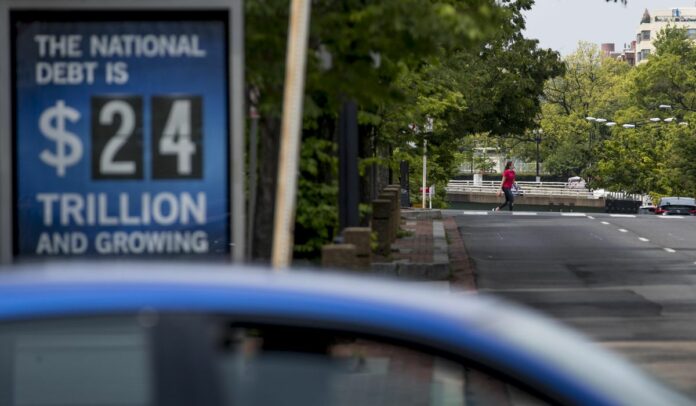Federal debt is nearing “unsustainable” levels, but low interest rates have created a window of opportunity for policy-makers to rein it in, the Congressional Budget Office said Monday, delivering a mixed outlook for the government’s long-term outlook.
Federal spending, currently 21% of gross domestic product, will rise to 31% by 2050, with most of that increase coming from interest payments on the rising debt, said Phillip J. Swagel, CBO’s director. Federal revenue, meanwhile, stood at just 16% of GDP last year, and will only reach 19% by 2050.
The gap between those spending and revenue numbers illustrates the problem.
“The fiscal path over the coming decades is unsustainable,” Mr. Swagel said in a stark statement describing CBO’s findings.
Federal debt held by the public will reach 98% of gross domestic product this year and will cross the 100% threshold next year.
It will reach a record 107% in 2023, and by 2050 — the end of CBO’s budget window — it will be a staggering 195% of GDP.
The coronavirus pandemic is a major cause of that, piling up debt this year and next, CBO said. But the problems run much deeper than virus spending.
Four of the government’s trust funds will be exhausted by 2031, including both Social Security funds, Medicare’s hospital insurance fund and the Highway Trust Fund.
Even treading water, much less making headway on the debt, will require significant sacrifices.
Mr. Swagel said it will mean sustained tax increases, spending cuts or a combination of the two, of nearly 3% of GDP a year.
If that began in 2025, it would add $2,200 that year to the average American’s tax bill or cost that much in lower federal spending.
Waiting longer to begin means even deeper spending cuts or tax hikes would be needed.
It’s not likely the economy can grow quickly enough to erase the need for spending cuts or tax increases, Mr. Swagel said.
Some economists have argued that the 100% debt mark is a clear danger sign for major world economies. CBO didn’t subscribe to that, but said there is some line out there.
“There is no set tipping point at which a fiscal crisis becomes likely or imminent, nor is there an identifiable point at which interest costs as a percentage of GDP become unsustainable. But as the debt grows, the risks become greater,” Mr. Swagel said.
Among the dangers are the more the government owes to foreign creditors, the less income the U.S. has. And the worse the budget picture, the less room the government has to maneuver in future fiscal crises, CBO said.






